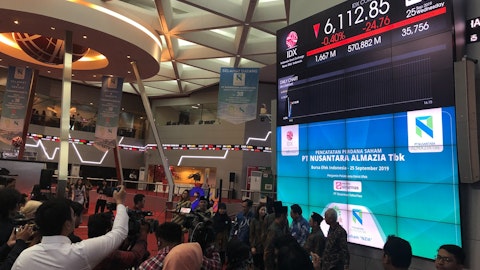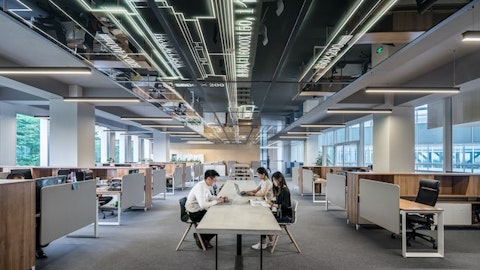Cadence Design Systems, Inc. (NASDAQ:CDNS) Q3 2023 Earnings Call Transcript October 23, 2023
Cadence Design Systems, Inc. beats earnings expectations. Reported EPS is $1.26, expectations were $1.21.
Operator: Good afternoon. My name is Bo, and I will be your conference operator today. At this time, I would like to welcome everyone to the Cadence Third Quarter 2023 Earnings Conference Call. All lines have been placed on mute to prevent any background noise. After the speakers’ prepared remarks, there will be a question-and-answer session. [Operator Instructions] Thank you. I will now turn the call over to Richard Gu, Vice President of Investor Relations for Cadence. Please go ahead, sir.
Richard Gu: Thank you, operator. I would like to welcome everyone to our third quarter of 2023 earnings conference call. I’m joined today by Anirudh Devgan, President and Chief Executive Officer; and John Wall, Senior Vice President and Chief Financial Officer. The webcast of this call and a copy of today’s prepared remarks will be available on our website at cadence.com. Today’s discussion will contain forward-looking statements, including our outlook on future business and operating results. Due to risks and uncertainties, actual results may differ materially from those projected or implied in today’s discussion. For information on factors that could cause actual results to differ, please refer to our SEC filings, including our most recent Forms 10-K and 10-Q, CFO commentary and today’s earnings release.
All forward-looking statements during this call are based on estimates and information available to us as of today, and we disclaim any obligation to update them. In addition, we will present certain non-GAAP measures, which should not be considered in isolation from, or as a substitute for, GAAP results. Reconciliations of GAAP to non-GAAP measures are included in today’s earnings release. For the Q&A session today, we’d ask that you observe a limit of one question and one follow-up. Now, I will turn the call over to Anirudh.
Anirudh Devgan: Thank you, Richard. Good afternoon, everyone, and thank you for joining us today. I’m pleased to report that Cadence delivered strong results for the third quarter of 2023. We exceeded our Q3 guidance on all key metrics and are raising our outlook for 2023. John will provide more details on our financials shortly. Notwithstanding the macro uncertainties, design activity remains strong, driven by transformative generational trends such as AI, hyperscale computing, 5G and autonomous driving. Growing hyperconvergence between electrical and mechanical domains, systems and semis, and hardware and software, is driving the need for tightly integrated co-design and analysis solutions. Additionally, trends such as a growing number of 3D-IC and chiplet designs, and system companies building custom silicon, are accelerating.
In this rapidly evolving design landscape, the relevance of AI-driven design automation cannot be overstated, as it’s enabling customers to accelerate their pace of innovation, while enabling them to meet their targets more efficiently. Over the past few years, we focused initially on incorporating powerful AI algorithms in our core engines, and then built our Generative AI solutions on top of our software platforms. We are seeing growing momentum for our comprehensive JedAI Generative AI platform, with an increasing number of customers adopting these solutions, and achieving exceptional quality of results and productivity gains. While still in the early stages, sales of our GenAI solutions have nearly tripled in the last year. Our solutions are enabling marquee AI infrastructure platform companies to deliver their next-generation compute, networking, and memory products.
Last quarter, we had referenced our successes with NVIDIA and Tesla. And this quarter, we’re pleased to announce that Broadcom has accelerated the adoption of Cadence Cerebrus across multiple business units, achieving impressive quality of results. In Q3, we pioneered leveraging GenAI’s LLM capabilities to chip design, successfully collaborating with Renesas on accelerating functional specification to final design. This is a key step in demonstrating the potential of LLMs to automate the translation of natural language specifications to final chip design and verification tasks, thereby boosting their quality and efficiency. We also renewed and deepened collaborations with some large semi and systems customers in the 5G, AI, hyperscale and connectivity areas.
For instance, we strengthened our long-standing partnership with a global marquee systems company through a significant expansion of our EDA software, hardware, design IP and system solutions. As the digital transformation in aerospace and defense accelerates, we continued our momentum by enhancing our core EDA and systems footprint with several customers, including at two market shaping companies. Now let me share some of the business highlights starting with Digital IC. With 11 new wins, our digital full flow delivering industry leading quality of results at the most advanced nodes, continued proliferating with market shaping customers. We are very pleased with the accelerating momentum of our flagship Cadence Cerebrus GenAI solution, whose transformative results have led to its deployment at all of our top 10 digital customers and in about 300 tapeouts to date.
Imagination Technologies used Cadence Cerebrus and our digital full flow on its latest 5 nanometer GPU design in the cloud, to achieve a 20% reduction in leakage power. Next, I will talk about our Functional Verification business, which had another strong quarter with 18% year-over-year revenue growth. Ever-growing system design complexity coupled with the need for first time right silicon, continued to drive strong demand for our Palladium Z2 and Protium X2 hardware platforms that provide industry-leading system verification and software bring-up capabilities. Our hardware business had a record Q3 with close to half of the hardware orders including both platforms. Highlights for the quarter included a major dynamic duo expansion with a top AI and automotive chip supplier, and a significant deal with a market shaping datacenter chip company.

A closeup of a software engineer architecting a cutting-edge Global Pricing Management application. Editorial photo for a financial news article. 8k. –ar 16:9
Our flagship Custom IC business continued to pave the way in analog innovation, delivering 15% year-over-year revenue growth. We’re pleased with the reception to our AI-driven Virtuoso Studio solution as several marquee customers adopt it for their N2 and N3 designs, and it has close to a thousand downloads since its launch six months ago. And Nisshinbo Micro Devices utilized the Virtuoso Studio Custom IC design platform to gain a 30% reduction in turnaround time for routing analog blocks. In Q3, we continued investing in our IP business and closed the acquisition of the Rambus PHY IP assets. Customer reception has been overwhelmingly positive to the addition of their HBM and GDDR IP to our Star Design IP portfolio. Design IP had a record bookings quarter with strong AI and chiplet design activity, especially in the mobile, automotive and hyperscaler verticals.
In addition, we launched our Tensilica Neo NPU IP and NeuroWeave software tools to accelerate on-device and edge AI performance. Our System Design and Analysis business that is driving our expansion beyond EDA continued to deliver strong growth, increasing revenue by 20% year-over-year. On the PCB front, Allegro X AI has several successful engagements with market-shaping customers underway, and we announced OrCAD X, our next-generation AI-driven PCB Design solution, enabled by Cadence OnCloud, and targeting small and medium businesses. Our Fidelity CFD platform continued its strong momentum with customers in automotive, aerospace and defense and industrial verticals. In summary, I’m pleased with our team’s continued innovation and execution.
We’re well positioned to benefit from the tremendous opportunities ahead, as we help customers design their differentiated products with improved quality of results, productivity and shorter time to market. I did want to take a moment to comment on the unfolding conflict in the Middle East. The ongoing violence and the loss of innocent lives is truly heartbreaking and a matter of global concern. The wellbeing of our employees and their families in the region is of utmost importance to us and we’ll continue doing everything we can to support them. Our thoughts are with everyone who has family, friends and loved ones there and we are helping out by providing humanitarian aid through the Cadence Giving Foundation. John will now go through the Q3 results and present our Q4 and updated 2023 outlook.
John Wall: Thanks, Anirudh, and good afternoon, everyone. I am pleased to report that Cadence delivered another strong quarter of top- and bottom-line results in Q3. All businesses contributed to revenue growth, and we completed more hardware installations in Q3 than we originally assumed. Here are some of the financial highlights from the third quarter, starting with the P&L. Total revenue was $1.023 billion. GAAP operating margin was 28.6%, and non-GAAP operating margin was 41.1%. GAAP EPS was $0.93, and non-GAAP EPS was $1.26. Next, turning to the balance sheet and cash flow. Cash balance at quarter-end was $962 million, while the principal value of debt outstanding was $650 million. Operating cash flow was $396 million. And we used $125 million to repurchase Cadence shares in Q3.
Before I provide our updated outlook, I’d like to highlight that our outlook contains the usual assumption that export control regulations that exist today remain substantially similar for the remainder of the year. Our updated outlook for fiscal 2023 is, revenue in the range of $4.06 billion to $4.1 billion. GAAP operating margin in the range of 30.5% to 31%. Non-GAAP operating margin in the range of 41.5% to 42%. GAAP EPS in the range of $3.48 to $3.54. Non-GAAP EPS in the range of $5.07 to $5.13. Operating cash flow in the range of $1.3 billion to $1.4 billion, and we expect to use at least 50% of our annual free cash flow to repurchase Cadence shares. As a result, for Q4, we expect revenue in the range of $1.039 billion to $1.079 billion.
GAAP operating margin of approximately 31%. Non-GAAP operating margin of approximately 42%. GAAP EPS in the range of $0.85 to $0.91. Non-GAAP EPS in the range of $1.30 to $1.36, and we expect to use approximately $125 million of cash to repurchase Cadence shares. As usual, we’ve published a CFO Commentary document on our Investor Relations website, which includes our outlook for additional items, as well as further analysis and GAAP to Non-GAAP reconciliations. In summary, we are on track to deliver a strong 2023. I am pleased with our team’s continued execution of our Intelligent System Design strategy. With our updated outlook for 2023, at the midpoint, we now expect: revenue growth of approximately 15%; non-GAAP operating margin of approximately 41.75%, a seventh consecutive year of greater than 50% incremental operating margin; and non-GAAP EPS of $5.10, a sixth consecutive year of high-teen or better non-GAAP EPS growth.
As always, I’d like to close by thanking our customers, partners, and our employees for their continued support. And with that, operator, we will now take questions.
Operator: Thank you. [Operator Instructions] And your first question comes from Charles Shi at Needham.
See also 20 Most Popular Scotch Whisky Brands in USA and 15 Highest Quality Fast Food Chains in the US.
Q&A Session
Follow Cadence Design Systems Inc (NASDAQ:CDNS)
Follow Cadence Design Systems Inc (NASDAQ:CDNS)
Charles Shi: Hey, good afternoon. Thanks for taking my question. I want to ask you a little bit about the backlog. It looks like your backlog compared with last quarter was up. I mean, the September quarter kind of implies very good bookings for September quarter. Just want to ask, do you see the backlog will continue to grow into the year-end? Because you talked about the second half booking strength. I want to see where it goes from here. Thank you.
John Wall: Yeah, Charles, thanks for the question, and thanks for remembering what we said last quarter. Yeah, we expect a very strong second half for bookings, and Q4 is exceptionally strong. But — so, our expectations for bookings is very, very strong Q4.
Charles Shi: Thanks. Maybe I want to ask a one quick follow-up. You kind of raised your full year revenue outlook a little bit less than you beat the Q3 in terms of revenue. It kind of implies that your full year outlook you provided one quarter ago was largely accurate, but there seems to be some timing shift for the revenue, I mean, pulling in from Q4 to Q3. Was that related to your comment about hardware installation, the timing of that? Thank you.
John Wall: That’s right, Charles. In hindsight now, I was a little too prudent in the Q3 guide with respect to hardware installations that were scheduled in China around the end of September. If you recall in our guide, we assumed that those installations would fall into Q4. In actual fact, we completed those hardware installations, and the second half looks stronger than we thought this time last quarter. But even with all of those hardware, we kind of beat our expectations in Q3 and Q4 is higher than we thought.
Charles Shi: Thank you.
Operator: Thank you. We go next now to Gianmarco Conti at Deutsche Bank.
Gianmarco Conti: Yeah. Hi, thank you for taking my questions. I guess my first one would be, when do you expect to be giving out more AI KPIs, whether on contract value uplift or penetration rates, or just, like, any color you can provide us on how can we quantify the AI tailwind in your numbers, and whether we are going to see this coming through in bookings in sometime? Thank you.
Anirudh Devgan: Yeah. Hi, it’s Anirudh. Let me take that. So, like we mentioned in the prepared remarks, we are seeing a lot of activity in AI. And that’s multiple customer and multiple verticals. So, whether it’s the system company designing their own chips, or, of course, the semiconductor companies designing it, or we mentioned this time, for example, Broadcom, which helps other companies design it. So, we are participating in the AI kind of design process in all three ways. And last time we talked about NVIDIA and Tesla. And then, on top of that, it’s also applying AI to our own products. And then, we have these extra generative AI products on top of our base products that also drives revenue. So, the first part, which is build out of the AI infrastructure, whether it’s with, of course, large semi companies like NVIDIA, or like large system companies like Tesla, or companies like Broadcom, I mean, that’s a big part of our business.
We don’t break that out specifically because it’s sometimes difficult to figure out exactly what part of customer’s business is AI or not, and we don’t want to be in that kind of to try to guess what part of our — what the customers are using it for. But AI is a significant portion of design activity and the buildout that’s going to happen for years. Now there’s a second part of our business in which we are selling AI products ourselves, like Cerebrus and Verisium and our JedAI platform, which has five main products. So in that segment, if our own software products and IP products are AI enabled, so in that, we did comment that even though it’s early in the process, our revenue from our own AI products has almost tripled from a year ago. So, we are very pleased with that progress.
So, I just want to highlight that, and also say there’s another part of AI, which is the buildout of infrastructure, which is more difficult to predict.
John Wall: And Gian, I would just add to that when Anirudh calls out that’s — the revenue from those products has almost tripled in the space of 12 months, we’re not reclassifying any revenue. This is direct revenue attributable to those five products that we have in our JedAI platform.
Gianmarco Conti: Right. That’s really good. Thank you. I just have a follow-up, perhaps talking a little bit on China. If you could comment on whether there is any impact from the entity list and the new rules come into place? And also, if you had any visibility into Chinese customers into trying to understand whether you actually know whether they’re designing at more mature versus advanced nodes? I feel like there’s been a lot of conversation around whether there is a way to track whether EDA tools are being used in China for mature versus advanced nodes. Any color on that — on this, it would be great. Thank you.
Anirudh Devgan: Yes, that’s a good question because there were a lot of recent reports on some of the changes in regulation. So for us, there’s not that much difference. Most of the regulations were targeted at some chip companies or manufacturing companies. As you know, we are in the design process. So those regulations, the latest round doesn’t have a big effect on Cadence business. Now there are some companies added to the entity list. So, we monitor that carefully. But since we are so diversified geographically and in terms of customers, that’s not a significant impact either. And all our guidance that we just gave includes the impact of all these regulations that were announced recently. And of course, we carefully follow all U.S. regulation. But the latest change is not that material to our business.
Gianmarco Conti: Okay, thank you.
Operator: Thank you. We’ll go next now to Harlan Sur at JPMorgan.




